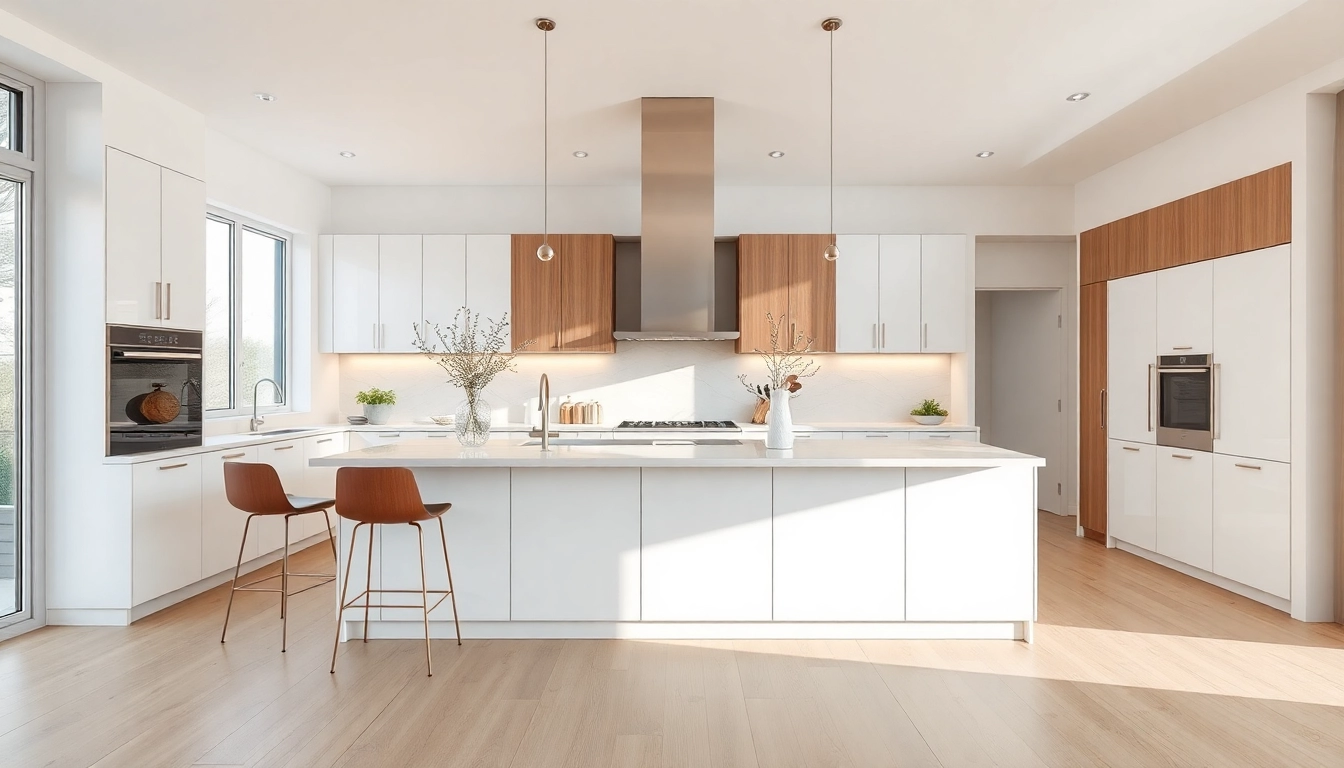1. Understanding Sliding Partition Walls
1.1 What is a Sliding Partition Wall?
A sliding partition wall is an architectural feature that allows spaces to be divided or transformed easily. This type of wall typically comprises panels that slide along a track, facilitating quick adjustments to a room’s layout. Unlike traditional fixed walls, sliding partition walls provide flexibility, enabling users to create separate areas for various functions without the need for permanent structures. Their versatility makes them an increasingly popular choice in both residential and commercial settings.
1.2 Key Benefits of Using Sliding Partition Walls
Sliding partition walls offer a plethora of benefits that enhance their appeal:
- Space Optimization: They are particularly useful in maximizing usable space, allowing areas to adapt to different needs—an essential feature in small apartments or multifunctional offices.
- Flexibility: Users can easily create large open spaces or intimate closed-off areas, relying on the ease of moving sliding panels.
- Sound Insulation: Many models are designed to provide excellent acoustic performance, making them suitable for environments requiring privacy, such as offices or therapy rooms.
- Aesthetic Appeal: Available in various styles and finishes, sliding partition walls can complement interior design and aesthetics.
- Cost-Effective: They represent a more affordable alternative to extensive renovations that would typically involve permanent walls.
1.3 Common Applications of Sliding Partition Walls
Sliding partition walls find applications in numerous settings:
- Residential Homes: They can create privacy in living areas, divide bedrooms from workspaces, or separate play areas for children.
- Corporate Offices: Many businesses use these partitions to develop flexible meeting spaces or collaboration zones that adapt to evolving team sizes.
- Public Spaces: Venues like hotels, convention centers, and restaurants utilize sliding walls to configure spaces for events or divide dining areas in peak hours.
- Educational Institutions: Classrooms can be divided for small group activities or merged for larger lectures, fostering versatile learning environments.
2. Choosing the Right Sliding Partition Wall for Your Needs
2.1 Material Options for Sliding Partition Walls
The material you choose for a sliding partition wall can significantly influence its functionality and visual appeal:
- Wood: Classic and warm, wooden panels offer aesthetic warmth and are often used in residential applications. They can be stained or finished to match existing decor.
- Glass: Ideal for promoting openness while ensuring privacy, glass sliding partitions are perfect for modern offices and commercial settings. They can include frosted options to maintain confidentiality.
- Fabric: Often used in temporary setups or where sound absorption is necessary, fabric panels can enhance acoustic control while adding color and texture.
- Metal: Durable and modern, metal partitions can offer a sleek, industrial look while providing robustness and longevity.
2.2 Design Considerations for Sliding Partition Walls
When selecting a sliding partition wall, consider the following design elements:
- Track System: Evaluate whether you want a ceiling-mounted or wall-mounted track system. Each has particular advantages depending on space and aesthetics.
- Panel Size: The dimensions of the panels should correlate with your space. Larger panels facilitate fewer movements and create dramatic effects, while smaller ones allow for more nuanced configurations.
- Functionality: Consider how often you’ll be moving the panels. Some models have features such as soft closing mechanisms or built-in locks for enhanced safety and ease of use.
- Color and Finish: Ensure that the finish complements or enhances the existing decor. Custom finishes can create a polished, cohesive look.
2.3 Size and Space Planning for Effective Implementation
Before installation, thorough planning is essential:
- Measure your Space: Accurate measurements will ensure the sliding doors will fit properly and function as intended.
- Determine Usage: Identify how and when the space will be used to decide on the optimal panel arrangement and functionality.
- Consult with an Expert: Engaging with a designer or architect can help navigate complex installation requirements and design nuances for seamless integration.
3. Installation Guide for Sliding Partition Walls
3.1 Tools and Materials Needed
Before you begin the installation process, gather the necessary tools and materials:
- Sliding wall panels
- Track system (ceiling or wall-mounted)
- Drill and drill bits
- Level
- Screwdriver
- Measuring tape
- Stud finder
- Safety goggles and gloves
3.2 Step-by-Step Installation Process
- Preparation: Begin by removing any existing fixtures or obstacles in the installation area.
- Mount the Track: Use a stud finder to locate secure points in the ceiling or wall. Mark the locations for your track. Attach the track according to the manufacturer’s instructions.
- Install the Panels: Lift the sliding panels onto the track one at a time. Ensure that they glide smoothly along the track.
- Adjust and Test: After installation, check the alignment and functionality of the panels. Make necessary adjustments to ensure proper opening and closing.
3.3 Common Mistakes to Avoid During Installation
To ensure a successful installation, steer clear of the following pitfalls:
- Inaccurate Measurements: Failing to measure correctly can result in panels that are too large or too small, causing installation issues.
- Neglecting a Level Surface: Ensure the area is level before installation; a sloped track can lead to malfunctioning panels.
- Ignoring Manufacturer Instructions: Always refer to specific installation guides provided by the manufacturer, as methods may vary.
4. Maintenance Tips for Sliding Partition Walls
4.1 Cleaning and Care for Longevity
Maintaining your sliding partition wall enhances its durability and appearance:
- Regular Dusting: Dust the panels and track system periodically, especially in environments with high dust accumulation.
- Gentle Cleaning Solutions: Use mild soap and water for cleaning. Avoid harsh chemicals that could affect finishes.
- Check Mechanisms: Periodically lubricate the sliding mechanism and check for any wear or damage to ensure smooth operation.
4.2 Troubleshooting Common Issues
If you encounter problems, here are common issues and solutions:
- Panels Sticking: This can often be resolved by checking for debris build-up on the track or ensuring the surface is level.
- Alignment Problems: If panels are misaligned, check the mounting of the track and adjust as necessary.
- Noise During Operation: If sliding panels creak or squeak, consider applying silicone lubricant to the track.
4.3 When to Seek Professional Help
If problems persist or installation seems beyond your skill level, do not hesitate to contact a professional. They can provide expertise in complex installations, adjustments, and repairs, ensuring a high-quality finish.
5. Inspiring Ideas for Using Sliding Partition Walls
5.1 Innovative Design Ideas for Homes
In residential settings, sliding partition walls can transform spaces creatively:
- Home Office Retreat: A sliding wall can segregate a home office from the living area, providing a dedicated workspace that can be hidden easily.
- Flexible Play Areas: For families, these walls can create adaptable play zones for children that can be closed off after use.
- Artistic Features: Customized panels can showcase artwork or fabric designs, enriching the decor while serving a functional purpose.
5.2 Creating Functional Office Spaces with Sliding Partitions
In the workplace, these walls enable dynamic environments:
- Collaboration Zones: Create adjustable areas for team brainstorming sessions that can be expanded or minimized based on need.
- Video Conferencing Rooms: Use sliding walls to create soundproof spaces for remote meetings, enhancing professional communication.
5.3 Transforming Commercial Spaces Using Sliding Partition Walls
Businesses can leverage sliding partitions to optimize consumer experiences:
- Event Space Layouts: Hotels and conference centers can quickly adjust layouts for events by sliding walls, adapting to attendee counts seamlessly.
- Restaurant Privacy: Cafes can partition diverse dining experiences to cater to both intimate gatherings and larger parties simultaneously.



